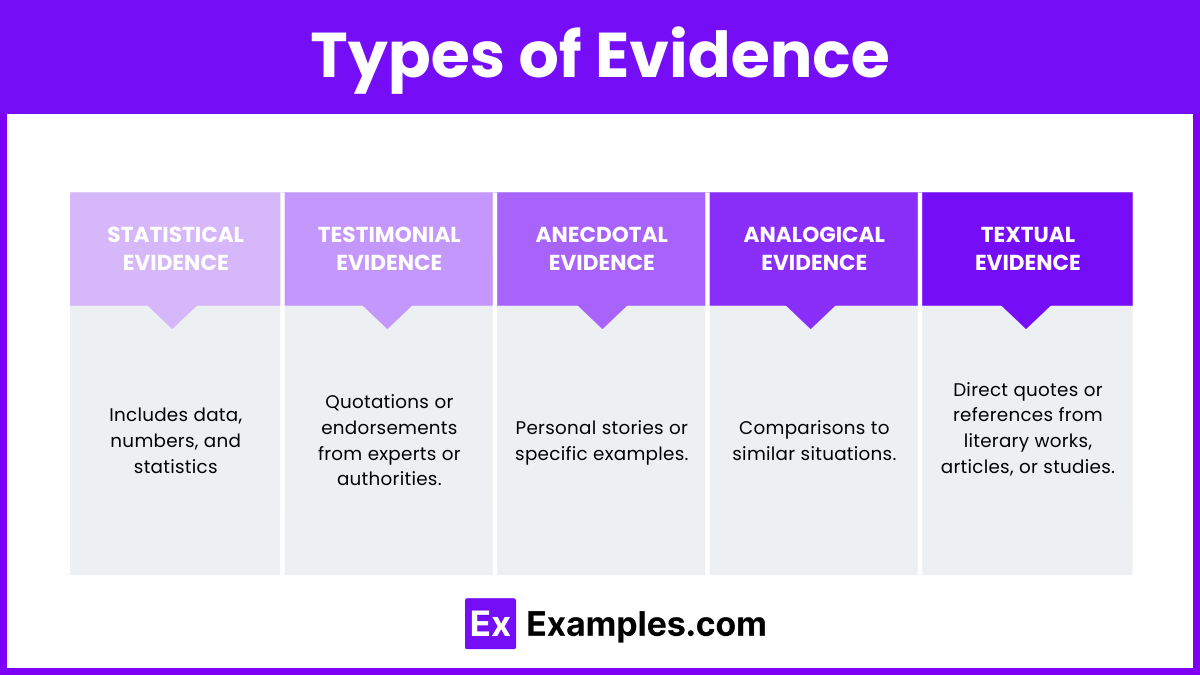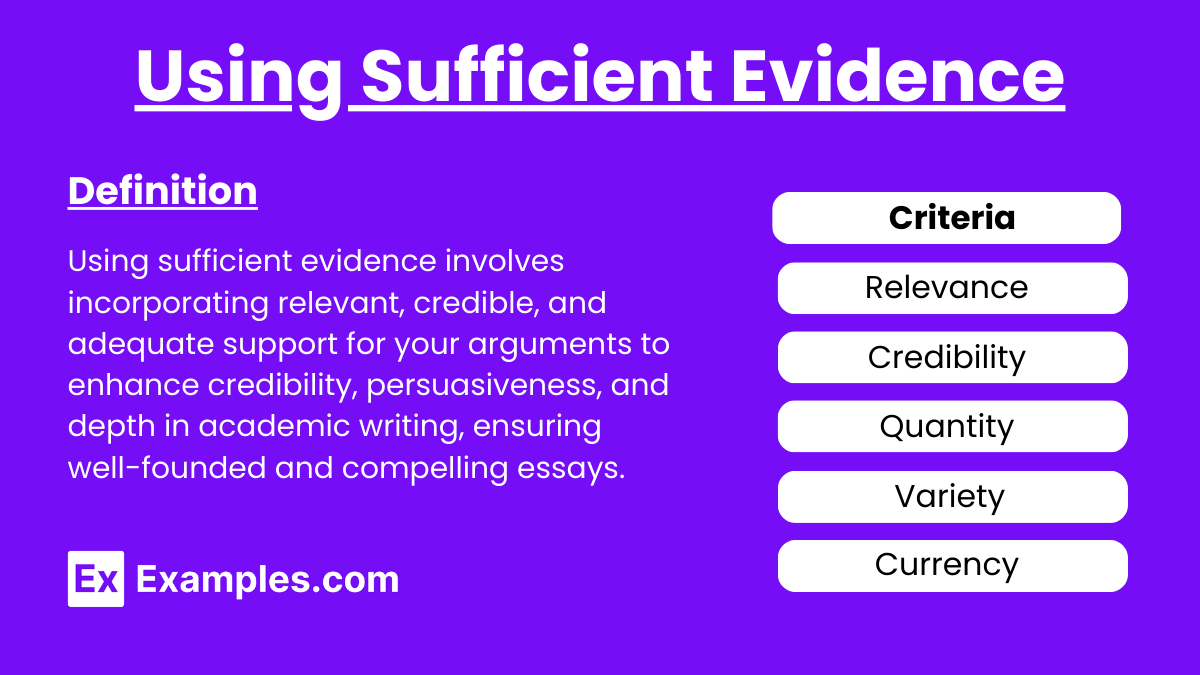In the realm of AP English Language and Composition, the ability to use sufficient evidence is a cornerstone of effective writing. Evidence serves as the backbone of any argument, lending credibility and persuasiveness to a writer’s claims. Whether crafting an argumentative essay, a synthesis essay, or a rhetorical analysis, integrating ample and relevant evidence is essential. This essay will explore the different types of evidence, the criteria for determining sufficiency, and the strategies for effectively integrating evidence into writing. By mastering these techniques, students can ensure their arguments are well-supported, compelling, and credible, thereby enhancing the overall quality and impact of their academic essays.
Learning Objectives
The learning objectives for the topic “Using Sufficient Evidence” are crucial for developing strong academic writing skills in AP English Language and Composition. Students will learn to identify and incorporate various types of evidence, including statistical, testimonial, anecdotal, analogical, and textual evidence, to support their arguments. They will understand how to evaluate the relevance, credibility, and sufficiency of evidence to ensure their arguments are well-founded and persuasive. Additionally, students will master techniques for seamlessly integrating evidence into their essays, using signal phrases, proper citations, and thorough analysis. These skills will enable students to construct robust, credible, and compelling arguments, enhancing their overall effectiveness in academic essay writing.
Importance of Sufficient Evidence
In AP English Language and Composition, using sufficient evidence is crucial for constructing well-supported arguments. Evidence enhances the credibility of your writing, persuades your audience, and substantiates your claims. Proper use of evidence ensures that your arguments are not based on personal opinions alone but are backed by verifiable facts and data.
Types of Evidence

- Statistical Evidence: Includes data, numbers, and statistics.
Example: “According to the CDC, vaccination rates increased by 15% in 2020.” - Testimonial Evidence: Quotations or endorsements from experts or authorities.
Example: “Dr. Anthony Fauci states that ‘wearing masks significantly reduces the transmission of airborne viruses.'” - Anecdotal Evidence: Personal stories or specific examples.
Example: “In my community, several families have benefited from the new healthcare policies.” - Analogical Evidence: Comparisons to similar situations.
Example: “Just as seat belts save lives in car accidents, helmets can prevent head injuries in cyclists.” - Textual Evidence: Direct quotes or references from literary works, articles, or studies.
Example: “Shakespeare’s use of irony in Macbeth reveals the protagonist’s tragic flaws.”
Criteria for Sufficient Evidence
- Relevance: Evidence must directly support your thesis and argument.
- Credibility: Use reliable and reputable sources.
- Quantity: Provide enough evidence to convincingly support your claims.
- Variety: Use different types of evidence to cover all aspects of your argument.
- Currency: Ensure evidence is up-to-date and reflects the most current understanding.
Integrating Evidence
- Introduce Evidence:
Provide context and source information.
Use signal phrases to lead into the evidence.
Example: “According to a 2021 study by Harvard University, …” - Present Evidence:
Quote, paraphrase, or summarize the source.
Ensure the evidence is clearly presented and accurately cited.
Example: “The study found that ‘regular physical activity reduces the risk of chronic diseases by up to 30%’ (Harvard 2021).” - Analyze Evidence:
Explain how the evidence supports your argument.
Discuss the implications and relevance of the evidence.
Example: “This data underscores the importance of incorporating regular exercise into daily routines to enhance overall health.”
Common Pitfalls to Avoid
- Cherry-Picking: Avoid selecting only evidence that supports your argument while ignoring contrary evidence.
- Overgeneralization: Ensure your evidence is specific and directly related to your claims.
- Plagiarism: Always cite your sources to give proper credit and avoid plagiarism.
- Insufficient Evidence: Providing too little evidence weakens your argument. Ensure you have enough to thoroughly support your thesis.
Examples of Using Sufficient Evidence
Example 1: Argumentative Essay
- Thesis Statement: “Implementing renewable energy sources is essential to combating climate change.”
- Evidence:
Statistical: “A study by the International Energy Agency found that renewable energy accounted for 72% of new power capacity additions in 2019.”
Testimonial: “Environmental scientist Dr. Jane Doe asserts, ‘Renewable energy is the most viable solution to reducing carbon emissions.'”
Analogical: “Just as the adoption of electric cars has reduced air pollution in urban areas, the shift to renewable energy can mitigate global warming.”
Example 2: Rhetorical Analysis Essay
- Thesis Statement: “Martin Luther King Jr.’s use of rhetorical strategies in his ‘I Have a Dream’ speech effectively conveys his vision for equality.”
- Evidence:
Textual: “King uses anaphora, repeating the phrase ‘I have a dream’ to emphasize his vision of racial harmony.”
Testimonial: “According to historian Dr. John Smith, ‘King’s speech is a masterpiece of rhetoric that profoundly impacted the civil rights movement.'”
Anecdotal: “Many individuals who attended the speech reported feeling a renewed sense of hope and determination to fight for civil rights.”
7. Practice Exercises
- Identify and Evaluate Evidence:
Read a passage and identify the types of evidence used.
Evaluate the relevance, credibility, and sufficiency of the evidence. - Integrate Evidence into Writing:
Write a paragraph supporting a thesis statement with at least three different types of evidence.
Practice introducing, presenting, and analyzing the evidence.
By mastering the use of sufficient evidence, students can strengthen their essays, making their arguments more compelling and credible. This skill is essential for success in AP English Language and Composition and in all forms of academic writing.


